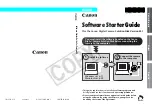
Using Naming Services and the Host Table
A-8
PortMaster Configuration Guide
Subnetting, Routing, and VLSMs
Routers and hosts can use the subnet field for routing. The rules for routing on subnets
are identical to the rules for routing on networks.
Releases before ComOS 3.5.
Before ComOS 3.5, correct routing required all subnets
of a network to be physically contiguous. The network must be set up so that it does not
require traffic between any two subnets to cross another network. Also, RFC 950
implicitly required that all subnets of a network have the same number of bits in the
subnet field. As a result, ComOS releases before ComOS 3.5 require the use of the same
subnet mask for all subnets of a network. ComOS used the value of 255.255.255.255 for
the user’s
Framed-IP-Netmask
regardless of the value of the attribute.
ComOS 3.5 and Later Releases.
ComOS 3.5 and subsequent releases support
variable-length subnet masks (VLSMs); therefore, the restrictions in earlier ComOS
releases no longer apply. The subnets of a network need not be physically contiguous
and can have subnet masks of different lengths.
However, ComOS still ignores the
Framed-IP-Netmask
value by default. To ease the
transition to use of VLSMs, ComOS sets
user-netmask
to
off
by default. This means
that all netmasks specified in the user table or RADIUS are treated as if they were
255.255.255.255. To use VLSMs and have ComOS accept the value in
Framed-IP-Netmask, enter the following commands:
Command>
set
user-netmask on
Command>
save all
Caution –
The VLSM feature affects both routing and proxy ARP on the PortMaster and
should be used with caution.
Using Naming Services and the Host Table
Naming services are used to associate IP addresses with hostnames. Many networks use
the Domain Name System (DNS) or the Network Information Service (NIS) for mapping
hostnames to IP addresses. Both services are used to identify and locate objects and
resources on the network. To use DNS or NIS, you must specify the IP address of the
name server during the configuration process.
!
Summary of Contents for PortMaster
Page 16: ...Contents xvi Configuration Guide for PortMaster Products...
Page 26: ...Subscribing to PortMaster Mailing Lists xxvi PortMaster Configuration Guide...
Page 32: ...Basic Configuration Steps 1 6 PortMaster Configuration Guide...
Page 114: ...Configuring WAN Port Settings 6 12 PortMaster Configuration Guide...
Page 128: ...Configuring Login Users 7 14 PortMaster Configuration Guide...
Page 158: ...Restricting User Access 9 16 PortMaster Configuration Guide...
Page 168: ...Configuring Ports for Modem Use 10 10 PortMaster Configuration Guide...
Page 222: ...Frame Relay Subinterfaces 13 16 PortMaster Configuration Guide...
Page 236: ...Troubleshooting a Synchronous V 25bis Connection 14 14 PortMaster Configuration Guide...
Page 252: ...Using ISDN for On Demand Connections 15 16 PortMaster Configuration Guide...
Page 264: ...Using ISDN for Internet Connections 16 12 PortMaster Configuration Guide...
Page 276: ...Configuration Steps for Dial In Access 17 12 PortMaster Configuration Guide...
Page 286: ...Configuration Steps for Shared Device Access 18 10 PortMaster Configuration Guide...
Page 296: ...Troubleshooting a Leased Line Connection 19 10 PortMaster Configuration Guide...
Page 310: ...B 4 PortMaster Configuration Guide...
Page 352: ...Command Index Command Index 6 PortMaster Configuration Guide...
















































